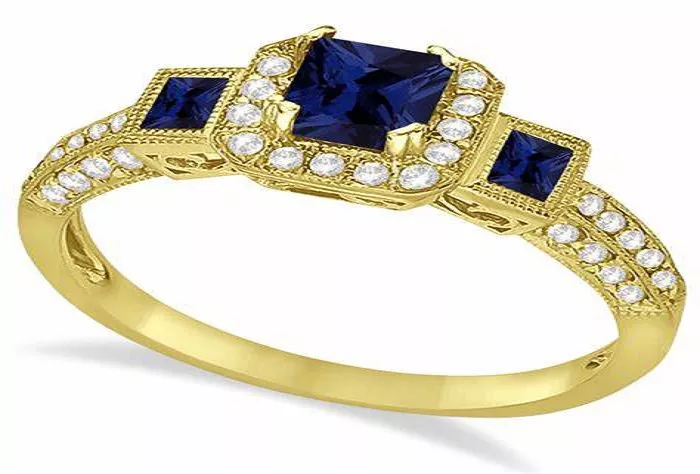A blue sapphire diamond gold ring is a stunning piece of jewelry that combines elegance, luxury, and deep symbolism. This ring features a captivating blue sapphire as its centerpiece, surrounded by sparkling diamonds, all set in lustrous gold. Whether worn as an engagement ring, a fashion statement, or a family heirloom, this ring never goes out of style.
In this article, we will explore the meaning and history of blue sapphires, the allure of diamonds and their role in jewelry, the types of gold used in rings, the design variations of blue sapphire diamond rings, how to choose the perfect ring, and care and maintenance tips.
By the end, you will understand why this ring is a cherished choice for many jewelry lovers.
The Enchanting Blue Sapphire
What Is a Blue Sapphire?
A blue sapphire is a precious gemstone from the corundum mineral family. It is known for its rich blue color, which ranges from light sky blue to deep royal blue. The most valuable sapphires have a vivid, velvety blue hue with strong saturation.
Symbolism and Meaning
Sapphires have long been associated with royalty and wisdom. Ancient kings and queens wore them for protection and clarity. They also symbolize trust and commitment, making them a popular choice for engagement rings. Some believe sapphires bring inner peace and mental focus.
Where Are Blue Sapphires Found?
The finest blue sapphires come from Kashmir in India, known for their cornflower blue color and velvety glow. Burma (Myanmar) produces deep blue sapphires with excellent clarity. Sri Lanka (Ceylon) offers a wide range of blue shades, from light to dark. Madagascar and Thailand also produce high-quality sapphires.
Sapphire Quality Factors
When buying a sapphire, consider color, clarity, cut, and carat weight. The best sapphires have a vivid, medium-dark blue color with few inclusions. A well-cut sapphire reflects light beautifully, with common cuts including oval, round, cushion, and emerald. Larger sapphires are rarer and more expensive.
The Brilliance of Diamonds
Why Diamonds in a Sapphire Ring?
Diamonds add sparkle and contrast to a blue sapphire ring. Their white brilliance makes the sapphire’s color stand out even more.
Diamond Quality (The 4 Cs)
The quality of diamonds is determined by cut, color, clarity, and carat weight. The best diamonds are colorless (D-F grade) and have excellent cut quality for maximum sparkle. Most jewelry uses VS (very slightly included) or SI (slightly included) diamonds for a balance of beauty and value.
Diamond Settings in Sapphire Rings
Popular settings include the halo setting, where diamonds surround the sapphire to make it look larger, and the pave setting, where tiny diamonds cover the band for extra sparkle. Side stone settings feature diamonds flanking the sapphire for a balanced look.
The Beauty of Gold
Types of Gold Used in Rings
Yellow gold is classic and warm, complementing blue sapphires beautifully. White gold is modern and sleek, enhancing the diamond’s sparkle. Rose gold is romantic and trendy, giving a soft, feminine touch. Platinum, though not gold, is a premium hypoallergenic metal often used in high-end rings.
Gold Purity (Karat)
Pure gold is 24K but too soft for rings. 18K gold (75% gold) is ideal for jewelry, offering durability and luxury. 14K gold (58.3% gold) is more affordable and very durable for everyday wear.
Design Variations of Blue Sapphire Diamond Gold Rings
Solitaire Sapphire Ring
A single blue sapphire in a simple gold band creates a timeless and elegant look.
Halo Sapphire Ring
The sapphire is encircled by small diamonds, adding extra brilliance and making the center stone appear larger.
Three-Stone Ring
Featuring a sapphire in the center with two side diamonds, this design symbolizes past, present, and future.
Vintage-Inspired Ring
Intricate filigree or Art Deco designs with milgrain detailing and engraved patterns offer a classic, romantic feel.
Eternity Band with Sapphires & Diamonds
Alternating sapphires and diamonds around the band make this perfect for wedding or anniversary rings.
How to Choose the Perfect Blue Sapphire Diamond Gold Ring
Determine Your Budget
Sapphire prices vary based on origin, color, and size. Diamonds increase the cost, especially high-clarity stones. Gold purity (18K vs. 14K) also affects price.
Select the Right Sapphire Shade
Royal blue is deep and vivid, cornflower blue is bright and medium, and teal blue offers a unique mix of blue and green.
Choose a Metal That Suits Your Style
Yellow gold is classic, white gold is modern, and rose gold is romantic.
Consider the Setting
Prong settings show more of the sapphire, bezel settings protect the gemstone, and channel settings secure diamonds along the band.
Check for Certification
Always ask for a gemstone report (e.g., GIA, AGL) for sapphires and a GIA or IGI certificate for diamonds.
Caring for Your Blue Sapphire Diamond Gold Ring
Cleaning Tips
Use mild soap and a soft brush to clean the ring. Ultrasonic cleaners are safe for sapphires and diamonds but check settings first. Professional cleaning every six months is recommended.
Storage Tips
Keep the ring in a soft pouch or separate compartment to avoid scratches. Avoid contact with harsh chemicals like perfume and chlorine.
Regular Maintenance
Check prongs yearly to prevent stone loss and re-polish gold every few years to restore shine.
Conclusion
A blue sapphire diamond gold ring is more than just jewelry—it’s a symbol of elegance, love, and timeless beauty. Whether you prefer a classic solitaire, a dazzling halo, or a vintage-inspired design, this ring will always make a statement.
By understanding sapphire quality, diamond brilliance, gold choices, and ring designs, you can select the perfect piece that reflects your style and lasts a lifetime.
Would you choose a royal blue sapphire in yellow gold or a cornflower blue in white gold? The choice is yours—each combination tells a unique story.
Related Topics:


